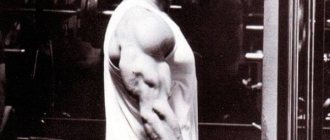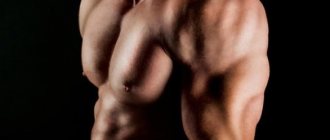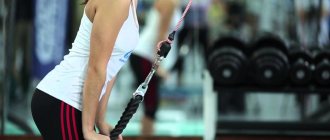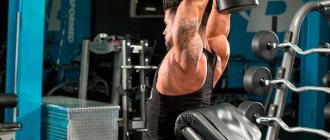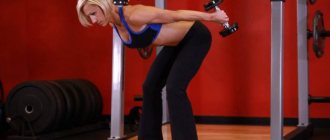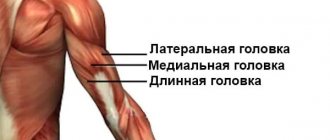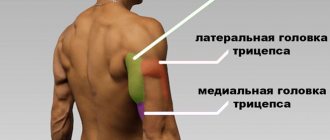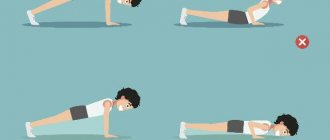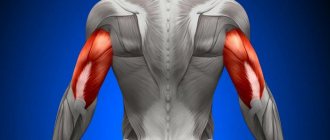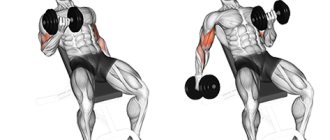The triceps extension on the upper block is a classic bodybuilding and fitness exercise. This is a common single-joint movement that is very popular due to its simplicity. But there are several technical nuances that allow you to feel the muscles being worked completely. Many people don't feel the triceps at all when they extend their elbows. They take too much weight and perform the exercise by swinging, due to inertia. These people should learn how to work in isolation and achieve their results faster. The movement is known with the classic straight and rope handle. The second option allows you to place more load on the lateral head of the muscle.
Execution technique
Initial position
- The movement starts from the point that many consider the middle of the amplitude. You need to start extending your arms from the “forearm parallel to the floor” position;
- You can take the correct position by standing at a distance of 30-40 cm from the crossover block;
- The handle should be grasped evenly, at the same distance from the center, with both hands;
- Bend slightly forward and slightly bend your knees;
- Take a breath, fix your abs;
- Reduce the shoulder blades to the spine and lower them to the pelvis;
- Keep your shoulders turned and in the same position
Movement
- As you exhale, you need to straighten your arms only at the elbow joints, leaving your shoulders stable;
- At the bottom point of the movement, you should linger, contracting your triceps;
- Then - return to the center of the amplitude and do not bend your elbows additionally in order to “push” the weight towards your shoulders;
- After completing the required number of repetitions, you need to return the projectile to its original position.
Attention
- The exercise is isolated - there is no need to “work” with your legs, body and abs;
- The more emphasis is placed on bending forward, the less stress the triceps receive;
- You cannot throw the weight in a negative phase; you need to smoothly lower it, as if “bringing it” with your muscles;
- You should control your elbows so that your forearms do not move too far from your body;
- The pace should be smooth and the same, there is no need to push the block down due to inertia and work in jerks
Recommendations
- The arms need to be extended exactly to the point where the tension is felt, but not overextended, “locking” the elbow;
- Do not bend your wrists so as not to overload the ligaments;
- It is better to keep brushes stiff;
- Block – keep suspended until the end of the exercise
This is a STANDING ARM EXTENSION, baby.
Extension of arms on a block with a direct grip
The exercise on the upper block with a straight grip is performed as follows:
- Set the required weight on the apparatus. Initially it should be small, but gradually it will need to be increased. Stand facing the machine. Place your hands on the handle so that your palms are on top of it, i.e. grab the handle with an overhand grip. The palms should be at a distance slightly narrower than shoulder width. Keep your back straight, bend your legs slightly at the knees and place them shoulder-width apart. Keep your socks parallel to each other. Tilt the body a little.
- Take a deep breath and lower your arms down. They should become straight. At the same time, tighten your triceps. Freeze in this position for 3 seconds.
- Exhale and come back. Repeat the exercise the prescribed number of times.
Analysis of the exercise
Working muscles
The main mover is the triceps, the triceps brachii muscle. The good thing about a pulley exercise is that it uses all three heads.
Additional muscles and stabilizers – muscles of the core, forearms, deltoids, latissimus, pectoralis, hips as stabilizers
pros
- It is considered “aesthetic”, developing only appearance, but this is not so. In strength sports it is used as a kind of “cool-down” after a heavy bench or standing press. Allows you to recover faster, which means it affects strength indicators, albeit indirectly;
- Can be performed in a gentle way - without putting a lot of stress on the elbows, does not stretch the ligaments, like many other triceps exercises, and is suitable for rehabilitation after injuries if performed with light weight;
- If you attach a rubber band to the block, it will be an excellent warm-up exercise before a heavy bench press due to variable changes in the load;
- At the end of the workout, you can, again, work with rubber or light weights to “drive” blood into the muscles and ensure recovery
Minuses
- Not designed for strength work, is unlikely to build powerful triceps if the athlete does not press and does not work in a strength mode in other exercises
Types of extensions
The choice of handle is important for the muscles being worked; for triceps, a straight device is considered the most suitable, with which you can exercise with different grips.
In addition to a short handle for the exercise, you can choose a wide device, but this option is better for working the back. For greater comfort and position of the hands, a V-shaped option is better.
When using a curved handle, you can shift the emphasis to the outer triceps. The brushes are positioned like this: the right one is clockwise, and the left one is the other way around. The position with a curved handle is more comfortable for the elbows, and the load on this area is less.
The rope handle allows you to work on the triceps muscle. For this exercise, only a neutral grip is suitable, but this relieves the elbows as much as possible. A D-shaped handle is suitable for working on each hand separately.
Alexander Shestov
TRX Certified Trainer
Ask a Question
If some types of handles are not available in the simulator, you can use variability with the existing equipment; this will only improve the effectiveness of the training.
Preparation for execution
Many people need to “mentally prepare” so as not to immediately take on the maximum weight. It’s impossible to hit anyone with this, but it’s easy to injure your shoulders. If you need to stand in front of the block with your shoulders rounded forward, the weight is too heavy, you need to take fewer tiles.
This exercise usually ends a bencher's or bodybuilder's workout. If used as a warm-up exercise, it is performed with rubber, or with minimal weight. When working the triceps in isolation with just this exercise (for example, during rehabilitation or in a program for a beginner), you need to warm up the joints before you start moving. Then – work with minimal weight.
When to perform extension according to plan?
Extension of the arms alone is not enough to better work the triceps, so this exercise is best done as a completion of classes on the days of classical arm training.
For example, you can first do the basics - bench press, dumbbell flyes, parallel bars exercises, then the French press and, in the finale, block triceps extension.
When to perform extension according to plan
Proper execution
- Bodybuilding reference books often say that an athlete should work with an extremely straight back and avoid bending forward. This is not entirely correct, a slight tilt is allowed, about 15 degrees. The movement should not be performed entirely by leaning and inertia;
- Elbows should not “walk” sideways and forward, or back and forth;
- A technical trick that allows you to perform the movement with the correct body position - gaze directed straight ahead;
- There is no point in starting from the front deltoids; in this position the biceps work more than the triceps in the exercise. You should not perform the movement using muscles that are not targeted by the exercise;
- The correct starting point is forearms parallel to the floor. The use of this technique does not allow you to lift heavy weights, and indirectly protects against ligament injuries;
- When using a rope handle, you need to monitor the position of your fingers; they should not seem to “huddle together”; the grip should be evenly distributed;
- When using a straight handle, control the wrists; their excessive extension or flexion is a technical error;
- Exhalation is carried out with effort, synchronization of extensions with breathing allows you to control the movement and helps to hold the body quite actively;
- Looking straight ahead will help keep your head in the correct position. You need to look forward, and not tilt your head to the side, so that the cable passes through the side.
Exercises for triceps. Arm extensions on the block.
Before you start training
Despite the fact that the exercise is relatively simple, pay attention to a number of contraindications to its implementation.
- If your elbows hurt, it is not recommended to do the exercise until the acute pain syndrome passes. It is advisable to do an MRI of the elbow joint to clarify the etiology (origin) of pain.
- If your wrists hurt, you should also let them recover. You can try using a medium-hard hand brace. If you do extensions with them painlessly, train calmly.
- After fractures, you need to wait a few weeks after removing the cast and start doing extensions with small weights. This will help restore ligaments and tendons that have become unaccustomed to stress and prepare the joint for further weights.
Errors
- Working with elbows “protruding” in different directions;
- A sharp, short body bend forward to help push the weight;
- Quick relaxation of the triceps after straightening the arms, “bouncing” the weight to the starting position by inertia;
- Full lowering of the weight, contact of the tiles with each other;
- Rolling the shoulders forward to create additional leverage;
- Walking out onto your toes, changing the position of your legs;
- Work in the shoulder joints and hands, which allows you to move the weight from a dead point
Varieties of grips and handles
There are many different handles for performing the bench press, but there are basic ones that are used most often. The choice of handle will determine your grip and also the degree of impact on the triceps heads.
Smooth handle. It is considered a more classic style of performing this exercise. If you grab the handle from above, the load will go to the medial and lateral heads of the triceps and you can work with more weight, but if you grab it from below, then the long head will be more loaded, and the weight will noticeably decrease.
Curved handle. Great for working the outer part of the triceps, or more precisely the lateral head, grip the handle from above, arms slightly turned inward.
Rope handle. This embodiment loads all 3 heads of the triceps, but this happens sequentially, at the beginning of the movement the lateral head works, at the very bottom the hands turn in different directions, thereby connecting the long and medial heads. The grip on the handle is neutral (palms facing each other).
V shaped handle. This is a kind of analogue of a rope handle. It only engages the lateral beam, but if you increase the weight, the long beam will also come into play. This handle relieves stress on the hands and is perfect for beginners. The grip is neutral.
Single handle. This handle is perfect for working out the long bun of each arm. Reverse grip (palm facing up).
Efficiency Tips
- To involve the triceps in the work, use a rope handle or attach rubber to the upper block evenly. This version of the exercise does not allow you to perform it with heavy weights, but this is not necessary. The straight handle helps to lock the hands more and perform the movement more isolated;
- A short pause at the lower permissible part of the amplitude will help to work the triceps more efficiently without using weights that are traumatic for joints and ligaments. In this case, there is no need to “press” and “insert your elbows” until it clicks;
- A “scissors” stance, when one leg is placed in front of the other, will help to actively engage the triceps in the work, if a person does not bend over like that, and stands stably, preventing the body from “working extra” and pushing the weight down due to inertia. Stepping is not a technical error, but rather a technique that helps some athletes;
- You can use a rigid handle to handle more weight. This makes sense if you bench press and need additional strength work after the main one. For beginners and those who train triceps in pump mode, it is better to use a cable handle for now;
- If your back gets tired during an exercise, it makes sense to change your legs;
- To maintain a smooth pace, you should do the exercise in a concentrated style, slowly extending your elbows for 2-3 counts;
- The exercise, when the elbows are extended from behind the head, significantly involves the shoulder joint in the work, and therefore is more difficult. It is demanding on the athlete's flexibility. If your shoulders are not very good yet, you should abandon this variation of the exercise.
Nuances
To load your triceps on a vertical block as efficiently as possible, follow these recommendations:
• squeeze the bar only using your triceps; • at the lowest point the forearms should be straightened; • do not throw the weight back up quickly; • press your elbow joints to your body and do not move them back; • use adequate working weight; • do not perform the exercise if you feel pain in your shoulders or elbows. • for greater isolation of the lateral head, you can perform the exercise with one hand.
Contraindications
• Standing block lifts are not performed after injuries to the elbow joints. • It is not recommended to perform a block press after surgery. • If you have recently suffered a wrist injury, it is recommended to reduce the aggravating weight by 40% of normal.
Inclusion in the program
Many people warm up with this movement. Of course, we are talking about the bench press. If we do the same, it is worth remembering the rules. To begin with, a joint warm-up and a couple of sets of extensions with light rubber. Then - 1-2 approaches with minimal block resistance. Those intending to bench press do not need to do high-rep pump sets in order to “work the triceps in advance.” This approach does not work well if a person really cares about results in the main exercise and healthy elbows. The purpose of the warm-up is to increase the local temperature of the muscles, improve blood supply and prepare for the main movement, and not to tire the muscles so that extension becomes completely impossible.
In classic fitness plans, the cable extension is the last triceps exercise. Here it is also important not to “insert” your elbows too actively, and to avoid too much inertial load. The purpose of the exercise is to work the triceps, and not to make the arms simply overworked, and the person gets injured due to a sharp “insertion” of the elbows.
In addition, you need to make sure that the extension is actually training the triceps, and not the “whole body”. Of course, the temptation to become known as “the strongest in the room” by extending your arms with the largest number of tiles is great, but you shouldn’t give in to it and just waste time, “swinging by inertia.”
Usually the movement is performed in a mode of 12 or more repetitions, but it is also possible to work in the range of 8 repetitions or even less.
How to correctly do extension from the upper block while standing down
The triceps pulley press is classified as an isolation exercise for one of the triceps heads. A properly performed deadlift will only engage that specific muscle group. The load helps to increase the relief and shape of the hands.
What triceps extensions look like in motion (video)
Advantages
To perform lat pulldowns, you will need a cable trainer. The exercise does not involve muscles other than the triceps. Performing arm extensions from the upper block is aimed at achieving the following goals:
•
increased strength of the triceps muscle; • isolated triceps load; • formation of hand relief; • reduction of skin “wings” in the shoulder area; • increase in arm volume; • strengthening of pressing characteristics.
